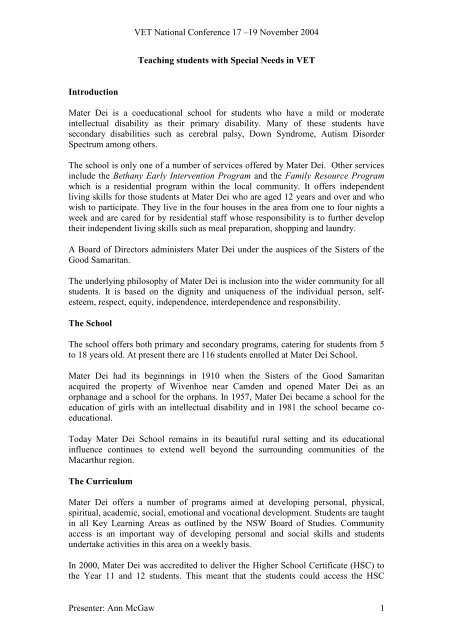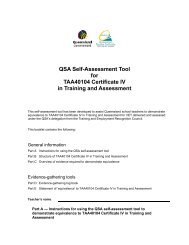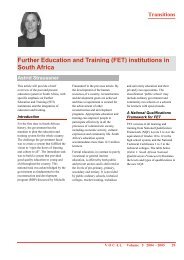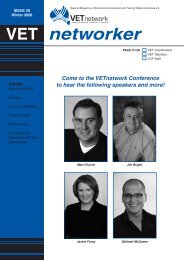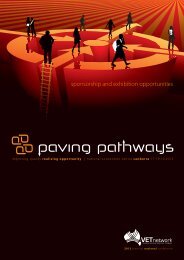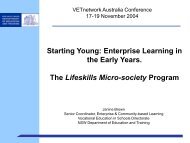Teaching students with Special Needs in VET - VETnetwork Australia
Teaching students with Special Needs in VET - VETnetwork Australia
Teaching students with Special Needs in VET - VETnetwork Australia
Create successful ePaper yourself
Turn your PDF publications into a flip-book with our unique Google optimized e-Paper software.
<strong>VET</strong> National Conference 17 –19 November 2004<strong>Teach<strong>in</strong>g</strong> <strong>students</strong> <strong>with</strong> <strong>Special</strong> <strong>Needs</strong> <strong>in</strong> <strong>VET</strong>IntroductionMater Dei is a coeducational school for <strong>students</strong> who have a mild or moderate<strong>in</strong>tellectual disability as their primary disability. Many of these <strong>students</strong> havesecondary disabilities such as cerebral palsy, Down Syndrome, Autism DisorderSpectrum among others.The school is only one of a number of services offered by Mater Dei. Other services<strong>in</strong>clude the Bethany Early Intervention Program and the Family Resource Programwhich is a residential program <strong>with</strong><strong>in</strong> the local community. It offers <strong>in</strong>dependentliv<strong>in</strong>g skills for those <strong>students</strong> at Mater Dei who are aged 12 years and over and whowish to participate. They live <strong>in</strong> the four houses <strong>in</strong> the area from one to four nights aweek and are cared for by residential staff whose responsibility is to further developtheir <strong>in</strong>dependent liv<strong>in</strong>g skills such as meal preparation, shopp<strong>in</strong>g and laundry.A Board of Directors adm<strong>in</strong>isters Mater Dei under the auspices of the Sisters of theGood Samaritan.The underly<strong>in</strong>g philosophy of Mater Dei is <strong>in</strong>clusion <strong>in</strong>to the wider community for all<strong>students</strong>. It is based on the dignity and uniqueness of the <strong>in</strong>dividual person, selfesteem,respect, equity, <strong>in</strong>dependence, <strong>in</strong>terdependence and responsibility.The SchoolThe school offers both primary and secondary programs, cater<strong>in</strong>g for <strong>students</strong> from 5to 18 years old. At present there are 116 <strong>students</strong> enrolled at Mater Dei School.Mater Dei had its beg<strong>in</strong>n<strong>in</strong>gs <strong>in</strong> 1910 when the Sisters of the Good Samaritanacquired the property of Wivenhoe near Camden and opened Mater Dei as anorphanage and a school for the orphans. In 1957, Mater Dei became a school for theeducation of girls <strong>with</strong> an <strong>in</strong>tellectual disability and <strong>in</strong> 1981 the school became coeducational.Today Mater Dei School rema<strong>in</strong>s <strong>in</strong> its beautiful rural sett<strong>in</strong>g and its educational<strong>in</strong>fluence cont<strong>in</strong>ues to extend well beyond the surround<strong>in</strong>g communities of theMacarthur region.The CurriculumMater Dei offers a number of programs aimed at develop<strong>in</strong>g personal, physical,spiritual, academic, social, emotional and vocational development. Students are taught<strong>in</strong> all Key Learn<strong>in</strong>g Areas as outl<strong>in</strong>ed by the NSW Board of Studies. Communityaccess is an important way of develop<strong>in</strong>g personal and social skills and <strong>students</strong>undertake activities <strong>in</strong> this area on a weekly basis.In 2000, Mater Dei was accredited to deliver the Higher School Certificate (HSC) tothe Year 11 and 12 <strong>students</strong>. This meant that the <strong>students</strong> could access the HSCPresenter: Ann McGaw 1
<strong>VET</strong> National Conference 17 –19 November 2004through the Stage 6 <strong>Special</strong> Program of Study which offers Life Skills courses such asEnglish Life and Mathematics Life Skills, as well as access to the VocationalEducation and Tra<strong>in</strong><strong>in</strong>g (<strong>VET</strong>) courses.The HSC is accompanied by a Statement of Atta<strong>in</strong>ment, which lists the <strong>students</strong>’achieved outcomes, which can give a clear picture to employers, ATLAS serviceproviders, future Residential support staff and other relevant personnel.Life Skills courses may form all or part of a <strong>Special</strong> Program of Study based onIndividual Transition Plans (ITPs).The completion of the ITP process for each student is a condition of access to theStage 6 <strong>Special</strong> Program of Study.Individual Transition Plan (ITP)Transition is simply a process of change or movement from one stage or phase toanother. It often <strong>in</strong>volves mov<strong>in</strong>g from one environment to another. The ITP is anessential feature of the transition process. It is essentially an organisational tool. Itfacilitates a successful transition of older <strong>students</strong> <strong>in</strong>to a range of employment,tra<strong>in</strong><strong>in</strong>g, liv<strong>in</strong>g and recreational options <strong>in</strong> the community.This <strong>in</strong>dividual plann<strong>in</strong>g enables the student, the parent/s or caregiver/s, the school,the social educators and other relevant staff to work together, exam<strong>in</strong><strong>in</strong>g options andopportunities for the future, identify<strong>in</strong>g barriers, sett<strong>in</strong>g goals and develop<strong>in</strong>g plansand strategies for achiev<strong>in</strong>g these goals.Students and their families must be the focal po<strong>in</strong>t for plann<strong>in</strong>g and implementation.The school program and the long-term transition plan used <strong>in</strong> the community afterleav<strong>in</strong>g school, needs to reflect what the student and the family want the plan to do <strong>in</strong>order for it to be successful.Presenter: Ann McGaw 2
<strong>VET</strong> National Conference 17 –19 November 2004The Individual Transition Plann<strong>in</strong>g ProcessITP date set by Coord<strong>in</strong>atorPastoral Teacher sends <strong>in</strong>vitations to complete preparatory form (Step 1) to: parents/carers/student, Family Resource Program other relevant personnel eg counsellors, employersThe ITP meet<strong>in</strong>gPastoral Teacher collates returned Step 1 forms and distributesStep 2 to members at ITP meet<strong>in</strong>g for discussionPastoral Teacher is the facilitator of ITP meet<strong>in</strong>g to: Review last year’s outcomes and achievements Identify post school options Discuss the desired annual outcomesResponsibilities are delegated to members of the ITP meet<strong>in</strong>gFollow-up from ITP meet<strong>in</strong>gITP is written by Pastoral Teacher and Posted to parent/s carers/student Posted to other relevant personnel Given to Family Resource Program 1 copy to student’s fileReview of ITP <strong>in</strong> 12 monthsPresenter: Ann McGaw 3
<strong>VET</strong> National Conference 17 –19 November 2004The Satellite ClassMany ma<strong>in</strong>stream schools are not able to offer the <strong>Special</strong> Program of Study to<strong>students</strong> <strong>with</strong> special education needs at their schools.In conjunction <strong>with</strong> John Therry Catholic High School and the Catholic EducationOffice, Wollongong (CEO), Mater Dei has established a Year 11/12 Satellite classoffer<strong>in</strong>g the Stage 6 <strong>Special</strong> Program to <strong>students</strong> from John Therry, Mater Dei and toother schools <strong>in</strong> the community.The <strong>students</strong> attend John Therry three days a week for the Life Skills courses and onthe other two days, use Mater Dei as their base to access the Structured WorkPlacement Program, the <strong>VET</strong> course offered by Mater Dei and as well as the MaterDei Community Access program.The Structured Work Placement Program (SWP)This program began <strong>in</strong> 1998, two years before <strong>students</strong> could access a VocationalEducation and Tra<strong>in</strong><strong>in</strong>g (<strong>VET</strong>) course and before the work placement component ofthe <strong>VET</strong> course was added.The purpose of the non-mandatory work placements is to teach our <strong>students</strong> the socialskills needed <strong>in</strong> the work place such as punctuality, stay<strong>in</strong>g on task, follow<strong>in</strong>gdirections and good manners.All the senior <strong>students</strong> at Mater Dei or <strong>in</strong> the Satellite class participate <strong>in</strong> theStructured Work Placement Program. They are learn<strong>in</strong>g at school and <strong>in</strong> theworkplace. They may be enrolled <strong>in</strong> <strong>in</strong>dustry specific structured workplace learn<strong>in</strong>g orthey may be enrolled <strong>in</strong> other programs such as Work and the Community Life Skills.Everyone goes to work at least one day of the week. Students participate <strong>in</strong> Meals onWheels teams, others work <strong>in</strong> McDonalds, Camden Council, and many otherbus<strong>in</strong>esses <strong>in</strong> the community. Students who do have to complete the mandatory workplacement of 70 hours may do this either by do<strong>in</strong>g a few hours a week or <strong>in</strong> a week’sblock. This decision is made <strong>in</strong>dividually for each student, depend<strong>in</strong>g on their stam<strong>in</strong>aand other contribut<strong>in</strong>g factors.The Vocational Education and Tra<strong>in</strong><strong>in</strong>g (<strong>VET</strong>) course.The <strong>students</strong> at Mater Dei all have special needs. For <strong>students</strong> to participate <strong>in</strong> the<strong>VET</strong> program they are given an Entry Level Test. This is a teacher-developed test at asuitable standard for the <strong>students</strong>. This test is not a pass or fail but provides the <strong>VET</strong>teacher <strong>with</strong> an <strong>in</strong>sight to each student’s ability. She is able to assess <strong>students</strong>’literacy, numeracy, comprehension and writ<strong>in</strong>g skills. The test<strong>in</strong>g is very basic andsome <strong>students</strong> may require assistance <strong>in</strong> complet<strong>in</strong>g all or part of the test. The test<strong>in</strong>gprocess commences from the <strong>students</strong>’ ability to write their name and copy the datefrom the board. At all times <strong>students</strong> are encouraged to do their best and seek helpand guidance when needed.Presenter: Ann McGaw 4
<strong>VET</strong> National Conference 17 –19 November 2004The class sizes are kept small so each student has the best possible chances ofachiev<strong>in</strong>g.The <strong>VET</strong> course is accredited by the NSW Board of studies, and, just as importantly,by employers. The course offered at Mater Dei is Bus<strong>in</strong>ess Services and teaches officeskills such as word process<strong>in</strong>g, letter writ<strong>in</strong>g, putt<strong>in</strong>g letters <strong>in</strong>to envelopes,photocopy<strong>in</strong>g, fil<strong>in</strong>g, and us<strong>in</strong>g the telephone and answer<strong>in</strong>g mach<strong>in</strong>e.However, if the student chooses not to cont<strong>in</strong>ue <strong>with</strong> the course after they leaveschool, they can use their skills <strong>in</strong> other environments eg use the telephone at home,use their word process<strong>in</strong>g skills to write letters and use the Internet to pursue their<strong>in</strong>terests.A qualified teacher skilled <strong>in</strong> tra<strong>in</strong><strong>in</strong>g and assess<strong>in</strong>g <strong>students</strong> <strong>with</strong> disabilities teachesthe Bus<strong>in</strong>ess Services course.Included <strong>in</strong> this course is a mandatory work placement of 70 hours or more and the<strong>students</strong> have to be placed <strong>in</strong> office environments. A thorough work read<strong>in</strong>essprogram is <strong>in</strong>tegrated <strong>in</strong>to the Bus<strong>in</strong>ess Service program to ensure that all <strong>students</strong> areequipped to spend time <strong>in</strong> the workplace. It is hoped that the <strong>students</strong>’ participation <strong>in</strong>the overall Structured Work Placement Program has also equipped them better <strong>with</strong>the necessary social skills for acceptance <strong>in</strong> the work place.It is important to give <strong>students</strong> <strong>with</strong> any disability the opportunities, such asparticipation <strong>in</strong> a <strong>VET</strong> course that their peers <strong>in</strong> the ma<strong>in</strong>stream would be offered. The<strong>students</strong> at Mater Dei School share the usual adolescent problems as their peers, suchas <strong>in</strong>securities, family pressures, hormonal changes, and when given the opportunitiesto promote their capabilities, they can often surprise their mentors, families andfriends as well as themselves. Mater Dei is, of course, also aware of the need to avoiddiscrim<strong>in</strong>ation and to comply <strong>with</strong> the Disability Discrim<strong>in</strong>ation Act 1992 (DDA).There are three considerations <strong>in</strong> determ<strong>in</strong><strong>in</strong>g which <strong>students</strong> will enrol for theBus<strong>in</strong>ess Services course.In the first place, there must be an ITP meet<strong>in</strong>g. This particular meet<strong>in</strong>g is held at theend of Year 10 <strong>with</strong> the student, his/her parents/carers, his/her parents/carers, pastoralteacher, <strong>VET</strong> teacher and any other relevant personnel. Goals are established forhis/her adult life after leav<strong>in</strong>g school such as employment, cont<strong>in</strong>u<strong>in</strong>g education,liv<strong>in</strong>g <strong>in</strong> a residential group home, among others. Keep<strong>in</strong>g these goals <strong>in</strong> m<strong>in</strong>d, theannual outcomes for Year 11 are then determ<strong>in</strong>ed. The Stage 6 <strong>Special</strong> Program ofStudy is discussed as well as the Bus<strong>in</strong>ess Services course and whether the studentcan or wants to access this <strong>VET</strong> course.A second aspect is that the student may be quite capable of do<strong>in</strong>g the Bus<strong>in</strong>essServices course but may not want to do it.For example, Craig was a student at Mater Dei a few years ago and he was identifiedas hav<strong>in</strong>g Asberger’s. He hardly spoke but conversed <strong>in</strong> grunts. However, he couldcommunicate quite well. He had a love of maps and timetables and could look upanyth<strong>in</strong>g on the Internet. His great love was to work on the computer. At his ITPPresenter: Ann McGaw 5
<strong>VET</strong> National Conference 17 –19 November 2004meet<strong>in</strong>g there was enthusiasm from all participants <strong>in</strong>clud<strong>in</strong>g Craig, for him to enroll<strong>in</strong> the <strong>VET</strong> course. However, he only attended the first few lessons as he did not wantto be directed on the computer and was not <strong>in</strong>terested <strong>in</strong> any of the other aspects ofthe course.A third consideration is the student’s social skills and behaviour.Vanessa who is currently <strong>in</strong> Year 11 can read and write and she could easily mastersome of the competencies of the Bus<strong>in</strong>ess Services course. However, her behaviourcan be erratic and she can become quite violent when someth<strong>in</strong>g goes wrong <strong>in</strong> herworld. She can lose her self-control. She would not be able to perform her mandatorywork placement <strong>with</strong>out one-to-one support from a Mater Dei staff member. Theschool cannot afford this luxury. Vanessa has been a participat<strong>in</strong>g member of theStructured Work Placement Program but each time she has had to be <strong>with</strong>drawn fromthe work place eg Meals on Wheels and an hour a week at a Pre-school <strong>with</strong> support.The <strong>students</strong> learn the same content matter as their peers <strong>in</strong> the ma<strong>in</strong>stream. However,each lesson is adjusted to meet the needs of each student. These adjustments <strong>in</strong>cludeteacher-developed worksheets, repetition and practice, extra time to learn newconcepts and constant help from the teacher’s assistant.Up to date, there has not been any student who has succeeded <strong>in</strong> reach<strong>in</strong>g theCertificate 11. This is not so important as the student still receives from the NSWBoard of Studies a record of the competencies they have achieved. This record can beused when they are seek<strong>in</strong>g a job as the prospective employer can see what they cando.Characteristics of <strong>students</strong> <strong>with</strong> an <strong>in</strong>tellectual disabilityStudents <strong>with</strong> an <strong>in</strong>tellectual disability fall beh<strong>in</strong>d their peers <strong>in</strong> the ma<strong>in</strong>stream <strong>in</strong>their academic abilities. This is not always obvious when meet<strong>in</strong>g one of the <strong>students</strong>.For example,Laura is a popular attractive young lady <strong>in</strong> Year 11. She has many attributes andseems to understand what is go<strong>in</strong>g on <strong>in</strong> the community around her. She presents welland can hold a conversation on her own. After meet<strong>in</strong>g her, people walk awaywonder<strong>in</strong>g why a girl such as Laura is enrolled <strong>in</strong> Mater Dei. In fact, Laura has quitepoor academic skills and a limited knowledge of the world around her. She will dowell <strong>in</strong> life hopefully us<strong>in</strong>g her good present<strong>in</strong>g skills to manage this, but she canhardly read or write.Poor attention span is another characteristic of a student <strong>with</strong> an <strong>in</strong>tellectual disability.This has to be taken <strong>in</strong>to account <strong>in</strong> any teach<strong>in</strong>g situation, as often a student cannotsit and listen for a long time. Lessons need to be planned so that there are variationsthroughout the lesson to hold their attention.In general, the <strong>students</strong> are not practical th<strong>in</strong>kers. This can be illustrated not by theiracceptance that there is a problem but their lack of effort to resolve it. It may bebecause all their lives, their needs have been met by their families, friends andPresenter: Ann McGaw 6
<strong>VET</strong> National Conference 17 –19 November 2004teachers and they have not had to th<strong>in</strong>k for themselves. They need opportunities topractise problem-solv<strong>in</strong>g skills.Although it can be easy at times to motivate <strong>students</strong> to do th<strong>in</strong>gs (that they likedo<strong>in</strong>g) it is difficult for them to be self-motivated. This can be demonstrated at thework place. If they have completed the given task, they often will not look forsometh<strong>in</strong>g else to do. It is important to teach them that they need to look for anothertask <strong>in</strong> their preparation for work placement.A student <strong>with</strong> an <strong>in</strong>tellectual disability usually does not have a good self-conceptMany of them have experienced failure <strong>in</strong> the earlier years when they have not beenable to keep up <strong>with</strong> their sibl<strong>in</strong>gs or their peers, academically or otherwise. It is veryimportant to praise <strong>students</strong> when they make an effort and/or when they succeed <strong>in</strong>order to boost their confidence.Many <strong>students</strong> <strong>in</strong> Mater Dei demonstrate very good social skills and behaviour.However some <strong>students</strong> do not for various reasons such as poor self-concept, notbe<strong>in</strong>g able to do the work, or perhaps an accompany<strong>in</strong>g behaviour disorder. All thesecharacteristics could also match those of <strong>students</strong> <strong>in</strong> the ma<strong>in</strong>stream schools forexactly the same reasons. Consistent class rules, organized lessons, adjusted classwork and appropriate work placements accord<strong>in</strong>g to their needs and capabilities aresome suggestions to off-set unsuitable behaviour.Curriculum AdjustmentsAll worksheets have to be modified and adapted for Mater Dei <strong>students</strong>. Simplify<strong>in</strong>gall student notes and worksheets by enlarg<strong>in</strong>g the pr<strong>in</strong>t, focus<strong>in</strong>g on one step at a time,us<strong>in</strong>g visuals, diagrams, props and demonstrations to further enhance student learn<strong>in</strong>g.Students <strong>with</strong> special needs have great difficulty <strong>with</strong> ‘too much at once’. As theirwrit<strong>in</strong>g skills may be poor, note tak<strong>in</strong>g is kept to an absolute m<strong>in</strong>imum, if used at all.When <strong>in</strong>troduc<strong>in</strong>g a new topic, student notes are handed out, one page at a time. Thisis discussed while <strong>students</strong>’ <strong>in</strong>terest is be<strong>in</strong>g ma<strong>in</strong>ta<strong>in</strong>ed by always <strong>in</strong>volv<strong>in</strong>g the<strong>students</strong>. It may be as simple as the <strong>students</strong> highlight<strong>in</strong>g or underl<strong>in</strong><strong>in</strong>g importantpo<strong>in</strong>ts. A worksheet usually follows each page of <strong>students</strong>’ notes. This re<strong>in</strong>forces thelearn<strong>in</strong>g process, keeps <strong>students</strong> <strong>in</strong>volved, helps <strong>with</strong> their memory retention andprovides the teacher <strong>with</strong> feedback. If the topic is theory based, then the worksheetsare modified to <strong>in</strong>clude: a cloze passage, true or false, multiple-choice, circle thecorrect answer etc. This enables <strong>students</strong> to participate <strong>with</strong>out hav<strong>in</strong>g to write outcopious answers, which they may be <strong>in</strong>capable of do<strong>in</strong>g. Support is always giventhroughout each step.At the start of the lesson, it is important to catch the attention of the class. As theirattention span is quite short, the first <strong>in</strong>struction must be delivered clearly andconcisely. It is advisable to use one- or two- step <strong>in</strong>structions, as they will becomeconfused and not be able to follow them. These <strong>in</strong>structions need to be simply wordedso that they will be understood. It is a good idea to monitor the comprehension of the<strong>students</strong> by ask<strong>in</strong>g them to repeat the <strong>in</strong>struction.Presenter: Ann McGaw 7
<strong>VET</strong> National Conference 17 –19 November 2004Over the years, Mater Dei School has <strong>in</strong>creased its use of visual prompts as a result oftheir impact on improved student learn<strong>in</strong>g and understand<strong>in</strong>g. The computer symbolsoftware ‘Boardmaker’ has made a significant contribution to the <strong>in</strong>creased use ofvisual prompts. The Boardmaker symbols have been used <strong>in</strong> many ways eg to createvisual timetables, class rules and <strong>in</strong>dividual social stories.It is also a good idea to use visual cues <strong>in</strong> the <strong>VET</strong> studies, as they can give the<strong>students</strong> further clarification <strong>in</strong> their worksheets or as rules or rem<strong>in</strong>ders <strong>in</strong> thecomputer room/classroom.Not only do these <strong>students</strong> have learn<strong>in</strong>g and <strong>in</strong>tellectually disabilities, they may haveone or more physical disability. For example, one of the <strong>students</strong> who had only beenliv<strong>in</strong>g <strong>in</strong> <strong>Australia</strong> for several months and came from a non-English speak<strong>in</strong>gbackground, had Cerebral Palsy <strong>with</strong> the use of only one hand. Learn<strong>in</strong>g programshad to be modified <strong>in</strong> his use of the computer and the vast majority of bus<strong>in</strong>essequipment. Even a simple task of open<strong>in</strong>g the mail can be challeng<strong>in</strong>g for such astudent. It is amaz<strong>in</strong>g to see, <strong>with</strong> perseverance, patience and practice, how adeptsuch a student can become <strong>in</strong> do<strong>in</strong>g simple to complex tasks.Assessments are varied to suit both the <strong>students</strong> and the task be<strong>in</strong>g assessed. Theymay be <strong>in</strong> the form of written, oral question<strong>in</strong>g, by observation of practical tasks,completion of portfolios or student demonstrations. Tasks undertaken <strong>in</strong> the modeloffice are also used <strong>in</strong> the assessment process. All assessments are carefullyrecorded. To cater for the special needs of the <strong>students</strong>, the assessments are usuallybroken down <strong>in</strong>to smaller steps. Thus more assessments are undertaken. Eachassessment event is recorded and kept <strong>in</strong> a records folder under the relevant Unit ofCompetence. However, when <strong>students</strong> are demonstrat<strong>in</strong>g their competence <strong>in</strong> themodel office, then a holistic approach is taken.All written assessments are kept <strong>in</strong> <strong>students</strong>’ folders. Students have access to these asit allows for feedback and gives <strong>students</strong> another opportunity to ma<strong>in</strong>ta<strong>in</strong> and organisetheir own work. Students also have a Log Book, which is kept up to date ascompetencies are achieved.When undertak<strong>in</strong>g an assessment, <strong>students</strong> are well prepared. Not all <strong>students</strong> may doan assessment task at the same time. If they require more time <strong>in</strong> the learn<strong>in</strong>g process,they can complete the assessment at a later date. Some <strong>students</strong> may not be able tocomplete all assessment events. For example, one student has a speech impedimentand cannot complete all the tasks on oral communication. This student may not beable to meet all the requirements of this competency but there are other aspects theycan achieve, such as writ<strong>in</strong>g down messages and distribut<strong>in</strong>g them.Classroom StrategiesAs mentioned above, it is important to use one-step oral <strong>in</strong>structions which are keptsimple and clear. It is often important to give additional explanations on a one-to-onebasis to clarify the <strong>in</strong>struction.Presenter: Ann McGaw 8
<strong>VET</strong> National Conference 17 –19 November 2004Class rules should be simple and always written <strong>in</strong> a positive way eg sit upright at thecomputer not do not slouch. Often if they are displayed <strong>with</strong> visual cues, the <strong>students</strong>can understand them better.Teacher expectations should be poised slightly above what they th<strong>in</strong>k their <strong>students</strong>can do. The <strong>students</strong> need to make every effort to do surpass their own expectationsand they often can do this.Visual cues, as previously discussed, and practical exercises can assist <strong>students</strong> tolearn. Consequently the idea of a ‘model office’ came <strong>in</strong>to be<strong>in</strong>g. The <strong>VET</strong> teacherwas very fortunate <strong>in</strong> acquir<strong>in</strong>g an unused room and turn<strong>in</strong>g it <strong>in</strong>to a model office.With the help of some fund<strong>in</strong>g she was able to <strong>in</strong>stall a telephone l<strong>in</strong>e, repair anunused photocopier, connect the <strong>in</strong>ternet, purchase a telephone, answer<strong>in</strong>g mach<strong>in</strong>e,fax, a scanner, petty cash t<strong>in</strong>, colour pr<strong>in</strong>ter, bookcase, b<strong>in</strong>der, lam<strong>in</strong>ator, shredder,labell<strong>in</strong>g mach<strong>in</strong>e, fil<strong>in</strong>g equipment and a reasonable amount of consumables. Acomputer term<strong>in</strong>al was reused and an obsolete reception desk was claimed.The <strong>VET</strong> teacher now has a fully functional office where <strong>students</strong> can practise on anongo<strong>in</strong>g basis all the skills they have learned. This is a really good learn<strong>in</strong>g andassess<strong>in</strong>g tool and is <strong>in</strong> constant use throughout the lessons. Students are required toaccess messages from the answer<strong>in</strong>g mach<strong>in</strong>e, receive and send emails and faxes,complete petty cash vouchers, photocopy for staff members, b<strong>in</strong>d documents,lam<strong>in</strong>ate, collate, hole punch, fold letters, address envelopes, and the list goes on.The creation of the ‘model office’ has been a great boost to student learn<strong>in</strong>g. The<strong>students</strong> feel a real sense of worth when they are actually complet<strong>in</strong>g real life tasks forstaff members. Theory and practical lessons are re<strong>in</strong>forced <strong>in</strong> the office environment.This also better prepares the <strong>students</strong> for the workplace.Work Placement IssuesTravell<strong>in</strong>g <strong>in</strong>dependently to work usually is a requirement for a student <strong>with</strong> adisability. This <strong>in</strong>volves travel tra<strong>in</strong><strong>in</strong>g which can be quite successful. However, forMater Dei School, it is a major issue.The school is situated on a property of approximately 700 acres <strong>with</strong> a private road ofone kilometer to its front gates. This means <strong>students</strong> have to walk to the gates,keep<strong>in</strong>g <strong>in</strong> the m<strong>in</strong>d that they must have a very good sense of road and safety skills(which may be unreliable). An added problem is that there is no public transport alongthe road outside the gates. All the <strong>students</strong> are taxied to and from the school each day.Students go<strong>in</strong>g to work have to be transported by Mater Dei staff to and from work.This puts an enormous pressure on the school <strong>in</strong> terms of lack of staff and schoolvehicles. It can only be achieved by whole school participation which <strong>in</strong>volvesteamwork among the staff. For example, a class go<strong>in</strong>g out on community access canalso convey a student to work or a staff member accompany<strong>in</strong>g a student for <strong>in</strong>clusionto a ma<strong>in</strong>stream school can do the same. The staff of the Family Resource Programwork closely <strong>with</strong> the school program and travel tra<strong>in</strong> <strong>students</strong> from the residence towork and back. Parents <strong>in</strong> the area often travel tra<strong>in</strong> their children to do the same.Presenter: Ann McGaw 9
<strong>VET</strong> National Conference 17 –19 November 2004Work placement is ultimately the responsibility of the school and the teachers<strong>in</strong>volved. As <strong>in</strong> other ma<strong>in</strong>stream schools, the student is not the responsibility of theemployer but the school. Consequently, there must be a good rapport between theschool and the employer. For example,Christopher is a 17 year old student at Mater Dei who goes to work twice a week andpart of this work <strong>in</strong>cludes his <strong>VET</strong> placement. He can be quite manipulative <strong>with</strong> thetruth. When he told his supervisor that he had a doctor’s appo<strong>in</strong>tment and had toleave at lunchtime but had lost his note, she rang the workplace coord<strong>in</strong>ator atschool. As expected, there was no doctor’s appo<strong>in</strong>tment and his escapade was foiled.In order to prevent further attempts, a simple stratagem was put <strong>in</strong> place. Thesupervisor r<strong>in</strong>gs at any time there is an absence or a change <strong>in</strong> his rout<strong>in</strong>e.A student must be ready to go to work. Most <strong>students</strong> have already participated <strong>in</strong>some aspect of the Structured Work Placement Program and their social skills <strong>in</strong> thecommunity eg attitude to the supervisor, tak<strong>in</strong>g directions, listen<strong>in</strong>g skills have beenassessed. Individual measures have to be taken if the student is not ready for work.Luke <strong>in</strong> Year 11 participates <strong>in</strong> the <strong>VET</strong> course. He has good read<strong>in</strong>g and writ<strong>in</strong>gskills but a wicked sense of humour and an obsessive nature as a result of bra<strong>in</strong>damage from a car accident when he was a child. In order for him to be ready for hismandatory work placement, he spent one hour each week at his future workplacement <strong>with</strong> support from a staff member. This worked out quite well and it ishoped that he will cont<strong>in</strong>ue there <strong>in</strong>dependently for half a day a week. This plan onlyworked because the supervisor was receptive to the plan.Mater Dei School works closely <strong>with</strong> Macarthur Work Place Learn<strong>in</strong>g Program(MWLP). This program is responsible for plac<strong>in</strong>g all <strong>VET</strong> <strong>students</strong> <strong>in</strong> the Macarthurregion <strong>in</strong>to work placements. The Manager of the program pays special attention tothe <strong>students</strong> at Mater Dei and personally f<strong>in</strong>ds the work placements for the <strong>students</strong>.She visits the school, meets the <strong>students</strong> and discusses their placements <strong>with</strong> them,their teachers and the Structured Work Placement team. Feedback is also important <strong>in</strong>f<strong>in</strong>d<strong>in</strong>g successful work placements. This is a very productive arrangement.The employer does have responsibilities too. The student is under his/her supervisionand although the student has been tra<strong>in</strong>ed <strong>in</strong> OHS issues and social skills at work, aproblem could arise. It is the responsibility of the employer/supervisor to r<strong>in</strong>g theschool and relate any problems that are occurr<strong>in</strong>g. It is sometimes difficult for theemployer/supervisor to rel<strong>in</strong>quish their ideas of what should be done and to <strong>in</strong>formthe school. Their responsibility is to look out for the basic welfare of the student andto give them directions <strong>in</strong> the work place.A Shared Understand<strong>in</strong>gIt is important that all participants realize that <strong>VET</strong> is a viable option for <strong>students</strong> <strong>with</strong>disabilities who have as much right as their peers <strong>in</strong> the ma<strong>in</strong>stream to partake <strong>in</strong> the<strong>VET</strong> course. Employers must be aware that these <strong>students</strong>, <strong>in</strong> general, who work forthem are enthusiastic to be an ‘employee’ and are content to perform entry-level jobs.Presenter: Ann McGaw 10
<strong>VET</strong> National Conference 17 –19 November 2004The <strong>VET</strong> course can be taught to <strong>students</strong> <strong>with</strong> an <strong>in</strong>tellectual disability wheneffective learn<strong>in</strong>g and teach<strong>in</strong>g strategies are put <strong>in</strong>to place. Learn<strong>in</strong>g programs andassessments are developed and constantly modified to meet the <strong>in</strong>dividual needs ofeach student. It is not always the brightest or quickest that goes on and succeeds.Some exceptional <strong>students</strong> give up because they have never struggled <strong>with</strong> anyth<strong>in</strong>g<strong>in</strong> life before, and when faced <strong>with</strong> a long, steep learn<strong>in</strong>g curve, tire along the way.Often the ‘plodders’ keep go<strong>in</strong>g because they are used to life be<strong>in</strong>g difficult and theyhabitually persevere. Our <strong>students</strong> need to be supported and guided to reach theirpotential. Certa<strong>in</strong>ly teach<strong>in</strong>g strategies, assessments tasks, worksheets, student notes,student exercises need to be carefully planned, carefully developed, constantlyadjusted and reviewed to meet the needs and abilities of the <strong>students</strong> but to also meet<strong>in</strong>dustry needs based on the national <strong>in</strong>dustry competency standards. It takes a lot ofemotional energy but the rewards are tenfold.It is very important that the employers are <strong>in</strong>volved <strong>in</strong> the <strong>VET</strong> work placements. Toensure this, Mater Dei provides an annual morn<strong>in</strong>g tea for the employers to thankthem for their contribution and to give them a Certificate of Appreciation. TheStructured Work Placement team also has addressed Chamber of Commerce meet<strong>in</strong>gsto promote community awareness of the program and the advantages of provid<strong>in</strong>gwork placements for the <strong>students</strong>. The Work Place Coord<strong>in</strong>ator understands the valueof network<strong>in</strong>g and is a member of the MWLP Committee and the <strong>VET</strong> Coord<strong>in</strong>atorsCommittee <strong>with</strong> the CEO, Wollongong and attends other related functions.The <strong>VET</strong> teacher attends <strong>VET</strong> network meet<strong>in</strong>gs for teachers where issues, changes,new developments and availability of new and up-to-date resources are be<strong>in</strong>gdiscussed and implemented.The Catholic Education Office keeps her <strong>in</strong>formed <strong>with</strong> relevant changes, literatureand correspondence. The <strong>VET</strong> teacher takes every opportunity to attend conferencesand forums <strong>with</strong><strong>in</strong> the diocese to keep abreast of new curriculum and <strong>in</strong>dustry trends.Whilst visit<strong>in</strong>g <strong>in</strong>dustry for assess<strong>in</strong>g the suitability of work placement she also ga<strong>in</strong>sa current <strong>in</strong>sight <strong>in</strong>to their requirements, expectations and any new developmentsoccurr<strong>in</strong>g at the present time. As some of our <strong>students</strong> may require <strong>in</strong>itial supervisionat their work placement, she can ga<strong>in</strong> a better understand<strong>in</strong>g of <strong>in</strong>dustry.The Structured Work Placement team also attends professional development days tofurther their knowledge of disabilities, behaviour management, child protection issuesand student profiles.Teamwork at the school level, <strong>with</strong> MWLP and <strong>with</strong> employers is vital to the successof the <strong>VET</strong> program. The need to identify the issues of <strong>in</strong>volv<strong>in</strong>g <strong>students</strong> <strong>with</strong> an<strong>in</strong>tellectual disability <strong>in</strong> the <strong>VET</strong> course and to develop the course accord<strong>in</strong>g to<strong>in</strong>dividual needs as specified by the ITP is crucial <strong>in</strong> promot<strong>in</strong>g an effectivepedagogy.Presenter: Ann McGaw 11


